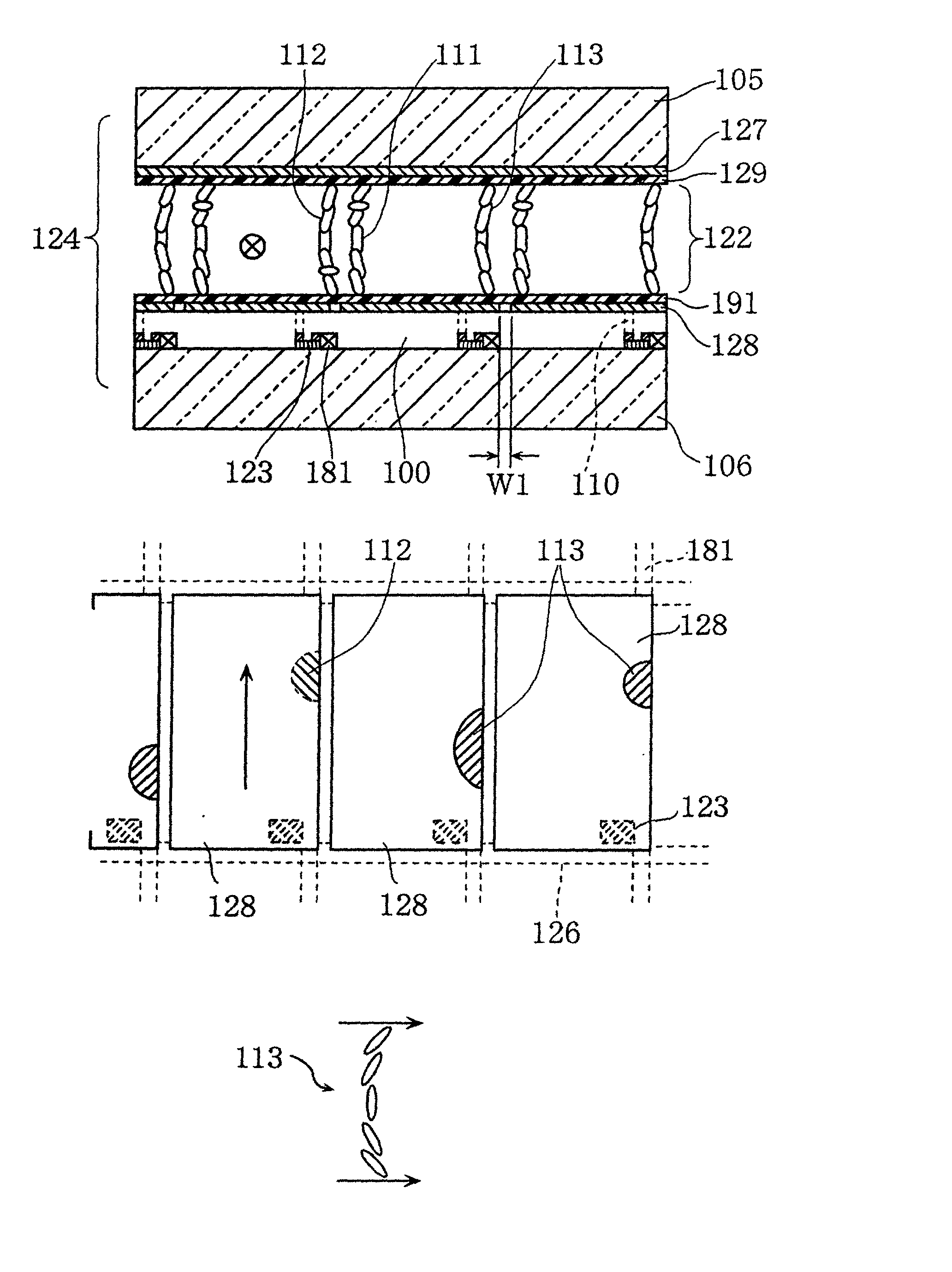Liquid crystal display and method of manufacture
a technology of liquid crystal display and liquid crystal, applied in non-linear optics, instruments, optics, etc., can solve the problems of narrow viewing angle, low response speed, serious problems in shock resistance and temperature characteristics, etc., and achieve wide viewing angle, high response speed, and substantial reliability
- Summary
- Abstract
- Description
- Claims
- Application Information
AI Technical Summary
Benefits of technology
Problems solved by technology
Method used
Image
Examples
embodiment 1
[0118] [Embodiment 1]
[0119] FIG. 1 shows conceptual structural views of a liquid crystal display constructed according to an embodiment 1 of the invention. Specifically, FIG. 1(a) is a conceptual structural sectional view showing the liquid crystal display on the basis of pixel unit; FIG. 1(b) is a conceptual structural plan view similarly showing the liquid crystal display on the basis of pixel unit; and FIG. 1(c) diagrammatically shows a bend alignment state and aligning direction of liquid crystal molecules as viewed from their sides.
[0120] The liquid crystal display of this embodiment has an active matrix type liquid crystal cell 124 at either or both sides of which two polarizers and a phase compensator for optical compensation (not shown) are provided.
[0121] The liquid crystal cell 124 has an opposed substrate 105 and an array substrate 106 which face each other. Arranged on the array substrate 106 are switching elements 123 made of TFT, source wiring electrodes 181 and others...
embodiment 2
[0142] [Embodiment 2]
[0143] FIG. 4 is conceptual structural views of a liquid crystal display constructed according to Embodiment 2 of the invention. Specifically, FIG. 4(a) is a conceptual structural sectional view showing the liquid crystal display on the basis of pixel unit, whereas FIG. 4(b) is a conceptual structural plan view similarly showing the liquid crystal display on the basis of pixel unit.
[0144] As shown in FIG. 4(a), the liquid crystal display of Embodiment 2 of the invention has an active matrix type liquid crystal cell 134 having, at either or both sides thereof, two polarizers and a phase compensator for optical compensation (not shown).
[0145] The liquid crystal cell 134 has the opposed substrate 105 and the array substrate 106 on which switching elements 133 made of TFT, the source wiring electrodes 181 and others are disposed. Laminated to the tops of the switching elements 133, the wiring electrodes 181 and others is the flattening film 100 made of a transparent...
embodiment 3-2
[0191] [Embodiment 3-2]
[0192] FIG. 9 shows a conceptual structural view of a liquid crystal display constructed according to an embodiment 3-2 of the invention.
[0193] As shown in FIG. 9(a), the liquid crystal display comprises an active matrix type liquid crystal cell 234 at either or both sides of which two polarizers and a phase compensator for optical compensation (these are not shown) are disposed.
[0194] The liquid crystal cell 234 has an opposed substrate 205 and an array substrate 206 which face each other. On the array substrate 206, a switching element 243 made of TFT, a gate wiring electrode and a source wiring electrode (not shown) are disposed for every pixel. Connected to each switching element 243 is the pixel electrode 271 made of ITO. An opposed electrode 217 made of ITO is formed on the opposed substrate 205.
[0195] Formed on the surfaces of the opposed and pixel electrodes 217, 271 are alignment layers 290, 291 in which the conductive particles 280 are mixed and disp...
PUM
 Login to View More
Login to View More Abstract
Description
Claims
Application Information
 Login to View More
Login to View More - R&D
- Intellectual Property
- Life Sciences
- Materials
- Tech Scout
- Unparalleled Data Quality
- Higher Quality Content
- 60% Fewer Hallucinations
Browse by: Latest US Patents, China's latest patents, Technical Efficacy Thesaurus, Application Domain, Technology Topic, Popular Technical Reports.
© 2025 PatSnap. All rights reserved.Legal|Privacy policy|Modern Slavery Act Transparency Statement|Sitemap|About US| Contact US: help@patsnap.com



